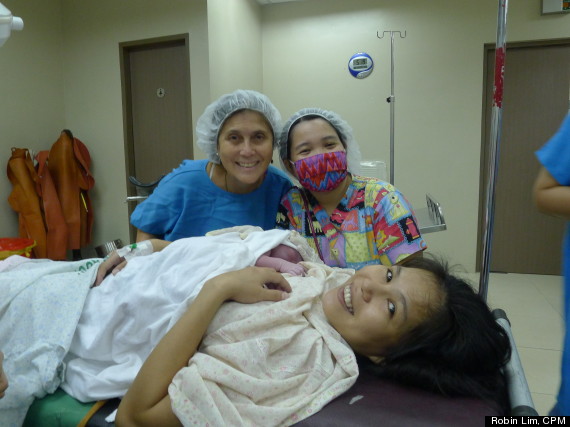The Philippines is my Motherland. My own mother was born and raised high in the mountain city of Baguio, where clouds walk with people. In the remote Cordillera mountain region my Lola, Vicenta Munar Lim, was a hilot, a healer and a baby catcher. Her heart, hands and indigenous herbs were her lifesaving tools.
Today in the Philippines, women and open-hearted men are at the forefront of a peaceful battle, the battle for Human Rights in Childbirth.
In October of 2014, we had a gentle triumph: Dr. Teodoro Herbosa the Undersecretary of the Department of Health for the Republic of the Philippines, came out publicly in favor of Gentle Childbirth.
Ted Herbosa did more than give lip-service to the challenges that face women in childbirth. He went with me to the EAMC East Avenue Medical Center, a huge hospital in Manila. He took off his shoes and he laid down, on the OB table, where women are normally forced to give birth. He put his feet in the stirrups. His eyes watered, he said, "I can't even breathe up here." And, for the benefit of all future mothers of the Philippines, he claimed; "We need to change the furniture in the birth rooms, it's not humane. Mothers need their dignity, especially when they are working so hard, to bring a baby into the world."
If you are jumping up and down in joy, I am with you. In fact, as I write about this, my eyes can't help but leak tears of happiness and relief. For the battle for human rights in childbirth has been long and uphill, while the blessings for mother and baby are mighty.
At EAMC, I was blessed to rub the backs of the many mothers in labor. The staff midwives, nurses and doctors were open to jumping in and gently encouraging the mothers. They were happy to learn the simple labor comfort measures that Doulas (women who mother the mothers) practice routinely. EAMC handles about 1,000 births per month, They are a tertiary care hospital. This means that many of the mothers arriving in labor have complications and are transported there by urban and rural midwives, who have determined that these mothers need special help in labor and delivery. The EAMC midwives, doctors and nurses give lifesaving care to mothers and babies, day and night. Our day together was a reminder to them that saving lives can be gentle, personal, and loving.
Dr Herbosa and I showed the entire OB team, gathered there in the delivery room, a short gentle water birth video made at Bumi Sehat in Bali. The mother in the film was smiling, her husband present and supportive. In the film the midwives gently received the baby into the world, the mother's hands also helping, with no hemorrhage, no complications, in spite of the fact that no interventions were used. The EAMC doctors and midwives watched the film twice, and they had many questions, smiles and some of their eyes were teary.
What happened next at EAMC was a full miracle of Gentle Birth (well, all births are a miracle). A third time mother arrived ready to push her baby into the light. Zhally was glowing, and calling out loudly in pain. I asked the OBGYNs gathered there if we could NOT put Zhally up on the OB table, so she would not be forced to put her feet in the stirrups. They were excited to try this. I spoke with Zhally and told her my name and that we were all happy to support her in the birth of her baby. I told her we were proud of her and that she was a champion. She smiled and thanked us, for connecting with her personally.
"When my other two children were born, no one even asked me my name," she said, and began to push.
"Good Zhally, breathe, slowly, gently." I asked the doctors to be totally hands-off, allowing the baby to spiral out of the birth canal, unimpeded. They watched in amazement, witnessing for the first time how the Fibonacci Spiral, so often observed in nature, is also how babies are born. Babies of all species do not push their way into the world straight ahead. When unobstructed, babies will spiral into the world, exiting the mother's yoni (birth canal) gracefully. This is exactly how Zhally's big baby boy arrived, spiraling into life.
When the baby was born to the waist, Dr. Joan and I cradled him gently, still half inside his mother, and we invited Zhally to bring her baby up to her own heart. What a triumph for the mother, so empowered to grasp her own baby, in her own hands, and bring him close, up onto her body, where she gazed into his eyes for the first time. All the while we doctors, midwives and nurses were singing:
"Alleluia... a-alleluuuuia
Wikain mo
Poon, nakikinig ako
... sa iyong mga salita
Alleluia ... allelu, Alleluuuuia"
"Alleluia... a-alleluuuuia
Speak and we
will listen to
your words
Alleluia ... allelu, Alleluuuuia"
We chose this song in Tagalog, because Zhally is Catholic. Muslim and Christian doctors joined in the singing. It was the first singing birth in one of Manila's largest hospitals. We hope it will become the norm here.

Like most Filipinos I am a work in progress. And no matter how long we train in western ways we will still need to find our way back to our roots in the birthing and healing traditions of our ancestors to know what will really liberate us. The structures and ways of the western institutions no matter how great and meaningful, will be alienating in some subtle way unless we find this reconciliation with what is meaningful to us in the ways of our traditional birth attendants. ~ Dr. Maria Elvisa Casals